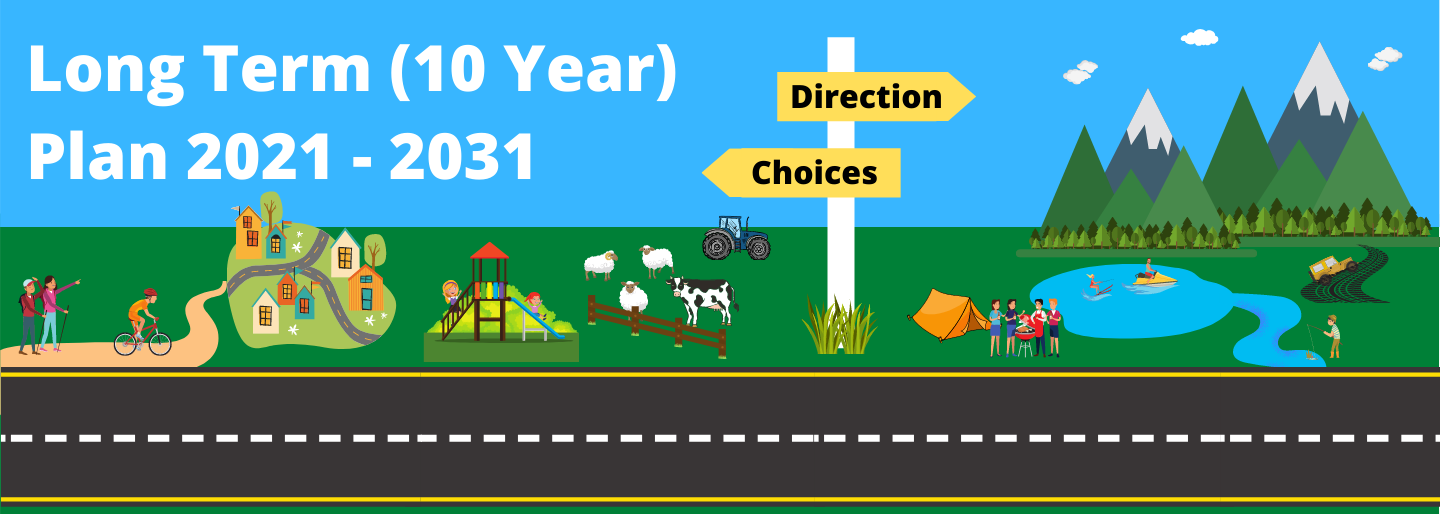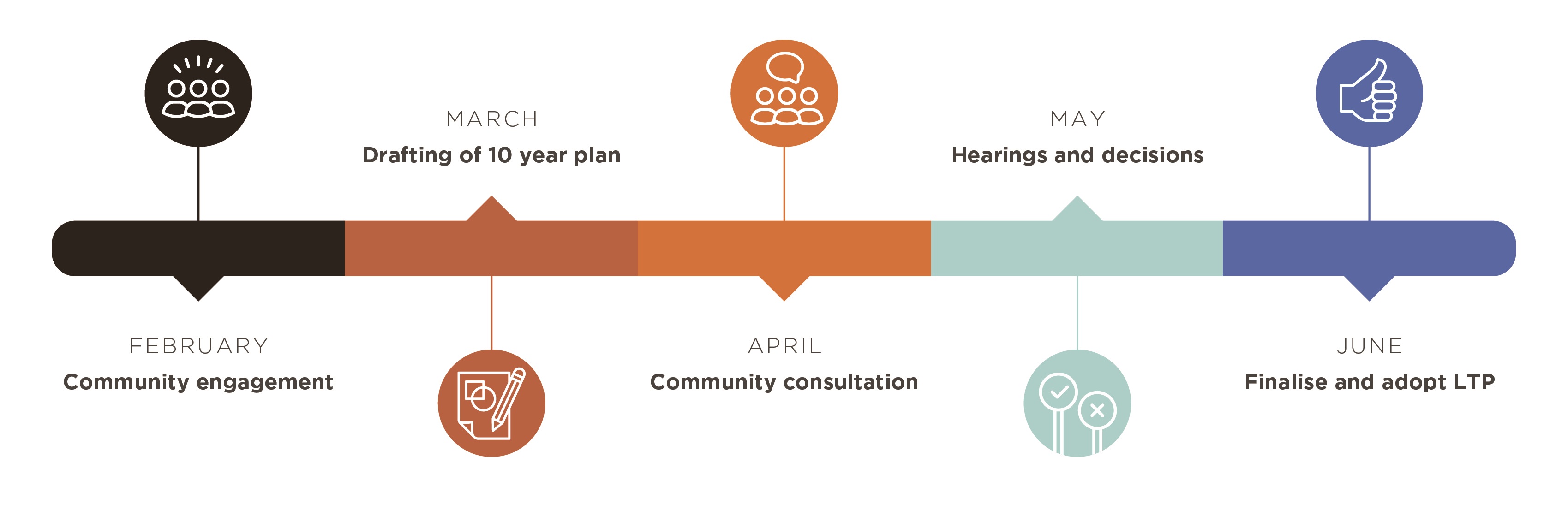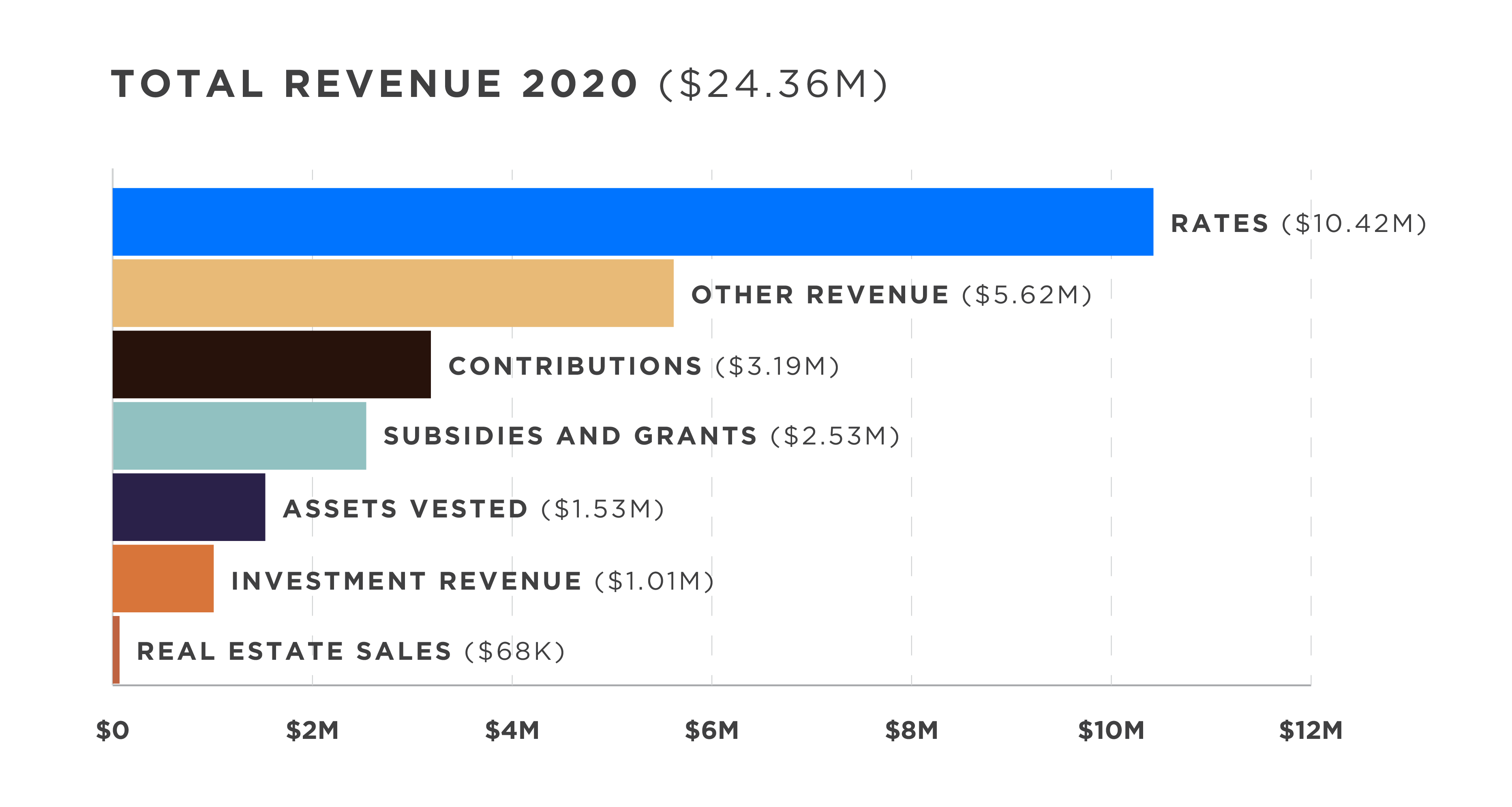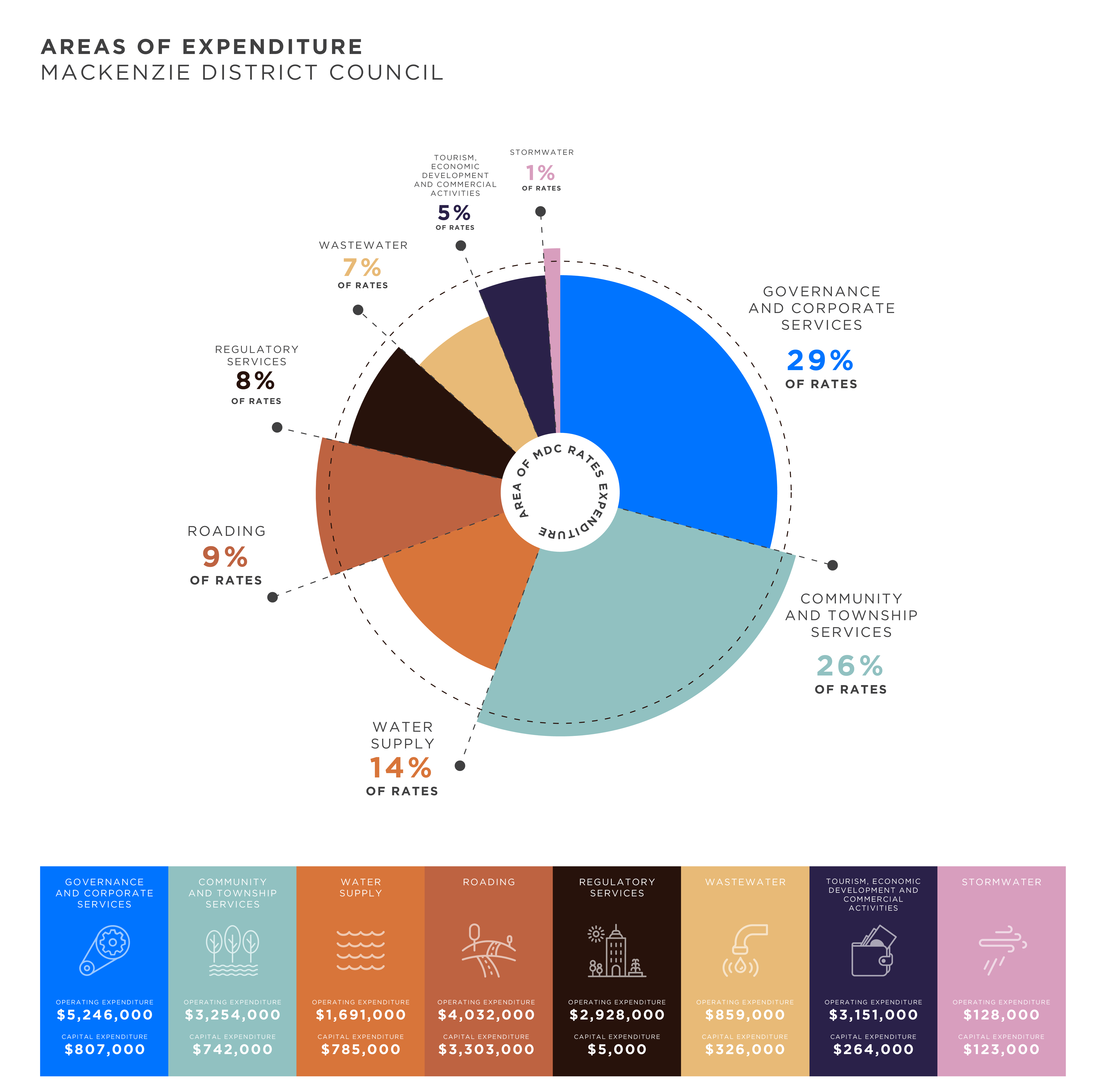We want to know what you think about some key issues before we create the draft Long Term Plan.
These include how we manage our rural halls in the future, how we improve our sustainability (both as a council organisation and across the district) and how we can better engage with our community.

What is the Long Term Plan?
The Long Term Plan (LTP) sets out everything we intend to deliver for the Mackenzie community over the next ten years, and how we intend to fund it.
The plan outlines the services and activities that we will provide, the projects we will carry out and the level of service the community can expect.
The plan also includes how much we expect things to cost, how we'll pay for them and what it all means for rates and debt.
An LTP looks a decade ahead, but is reviewed and consulted on every three years. An annual plan is prepared for the years in between.
Why is it important?
There are a number of significant projects underway that will guide our investment over the next ten years, these are outlined below, and include the District Plan Review, Mackenzie Spatial Plans and Te Manahuna Ki Uta/Destination Mackenzie (and more).
We are also dealing with the longer term effects of COVID-19, which will continue to impact our district over the foreseeable future. On top of this we have challenges around things like responding to climate change, planned drinking water, wastewater and stormwater reforms and other central government direction.
We think we need to keep doing what we're doing - investing in our district, improving our infrastructure, upgrading parks and reserves, and planning for the future. If we continue to invest, we'll be improving the district and helping our economic recovery.
How can I have my say?
The LTP affects every single person in our district and is developed through discussion with our residents and ratepayers, outlining a proposed work plan and how we propose to fund it.
Consultation is undertaken in line with the requirements of the Local Government Act 2002 and wider engagement on key topics aim to ensure everyone gets to know what's being considered, what the options are, and how they can have their say.
At this stage we are looking to begin an early conversation with the community to help us better understand the issues you think are important and what we should be focusing on. This will help us inform our draft LTP which will be formally consulted on in April this year.

There are a number of other issues we will be engaging with you on as we launch the LTP community consultation in April, and we'll keep everyone posted when we're ready to share that.
How does it all work?
How Should we pay for things?
Mackenzie District Council (MDC) gets its money from a range of sources - about 43% from rates, with the rest from fees and charges, subsidies, financial contributions, grants and property rentals, investments, property sales and debt funding.
How are your rates spent?
The level of rates set by the Council depends mainly on the services we have to provide, such as drinking water, wastewater and roads, and on what services and facilities the community wants.
If you own a property you pay rates directly to Council. Those who live in the district but don't own property also pay rates indirectly through their rent. As such, the LTP is important to all residents, whether or not you own property, and we want to hear from anyone with an interest in the district.
In general, our running costs, such as paying staff, maintaining parks and reserves, and keeping the lights on are paid for through rates and fees and charges. The below infographic has been designed to help you understand how your rates are spent.
Click the below infographic to view a larger version.
Rates for MDC residents have been traditionally kept low through the use of things like property sales profits, carbon credits and forestry sales. While this has ensured rates have stayed low (we're the third lowest in the country), it isn't a sustainable way of continuing to maintain and progressively improve our services, infrastructure and our district.
Our residents and ratepayers expect a certain level of service, however this, like everything, needs to be paid for. This means there is an ongoing balancing act that needs to happen to get the right mix of the delivery of council services versus the cost of rates.
We want to get that balance right, and this is why we're looking for your input at this early point in the LTP process. We want to have an honest and open conversation up front, so everyone is on the same page and understands the pressures we all have to deal with to ensure that we get the best results for our communities.
There are a number of issues on the horizon that will require significant investment from our communities, and we need to have a discussion as a community about what constitutes an appropriate level of service, the trade offs that might be required, and how we should pay for improvements, repairs and new services.
Big Changes
Simply put, there is heaps happening in the District at present. We're tackling some big strategic projects which will inform our future planning, once they are complete by the end of the year. These include:
Three Waters reform
The government led water reforms are the most significant changes to local government since the reforms of 1989. In the wake of the Havelock North Inquiry and subsequent Three Waters Review, central government is embarking on significant water reform which will establish a new water regulator - Taumata Arowai, and big changes to the way water services are delivered nationwide. While the impacts of this change are yet to be finalised, it appears likely that water will be delivered by a new statutory authority instead of council.
District Plan Review
The District Plan guides land use and development across our district. It sets out what activities you can do as of right, what activities you need resource consent for, and how certain activities may be carried out. It covers things like residential development, noise, location and height of buildings, and protection of indigenous vegetation.
We are currently reviewing our District Plan and expect to notify a draft of the proposed District Plan in early 2022.
The Mackenzie Spatial Plans
The Mackenzie Spatial Plans will create a 30-year vision of what the future could look like in Fairlie, Takapō/Tekapo and Twizel. The project will ensure our main townships are maintained as places for people, ensuring growth can occur in a sustainable way that benefits the local community and improves where we live.
A Spatial Plan is a visual blueprint for the future, showing what should go where and how each part should interact with the others. We want to ensure we can get ahead of growth, identify key improvements including our infrastructure requirements, then plan for it and get on with it. These are expected to be finalised in the first half of 2021 and will inform changes to the District Plan.
Te Manahuna Ki Uta/Destination Mackenzie
Te Manahuna Ki Uta/Destination Mackenzie is a multi-partner strategic planning process for the Mackenzie District led by Mackenzie District Council.
The project will develop a Destination Management Plan for the Te Manahuna/Mackenzie District as part of a wider tourism journey that includes Aoraki Mt Cook National Park, the upper Waitaki Valley and the Lindis Pass.
A Destination Management plan provides a coordinated approach to the management of all the aspects that contribute to a visitor's experience, including residents, business, industry, and Iwi. It aims to create a sustainable and resilient tourism eco-system for the benefit of the local community. This will be completed by the end of 2021.
Parks Strategy
We have identified a number of challenges with how we manage our parks and open spaces and we're putting together a Parks Strategy to help us better plan for and maintain our current parks. It will also help us understand what provision we need to make for future parks and reserves and what sort of level of capital and operational expenditure these require. This will help us inform the investment required and ensure we continue to make use of our outstanding outdoor spaces. This will be completed in September this year.
Play Strategy
We're currently developing a district-wide Play Strategy that will help us understand the future investment required to ensure the district has the right amount of playgrounds and play spaces for our children and young people. This strategy will provide a comprehensive understanding of the current assets and where future investment should be targeted to support the community's needs and those of visitors to the district. This is expected to be completed by June this year.
Trails Strategy
We know our district has world class walking and cycling trails and significant opportunities exists to improve this network. We have commissioned a Trails Strategy to help us form a coherent view of how our trails network can be improved and expanded to provide for both residents and visitors to the District. We believe our tail network can become a significant asset to our community and we want to ensure investment is targeted in the right areas and for the right reasons. This is expected to be completed by October this year.
Review of Council Buildings
Council owns and maintains a number of buildings around the district for both community and council purposes. There is a mixed amount of understanding about the state of this property portfolio and we will be undertaking a review of Council-owned building stock this year. This will look at the physical state, maintenance required, current use and cost of each building, and will be used to inform future conversations around these buildings and their future use.
Key issues
While the above projects will offer a lot of direction to Council once complete, there are a number of issues that we can get on with right now, and we want your input to ensure we're heading in the right direction.
You can learn more about these issues and share your thoughts with us by filling out the survey available here.
Other issues
The above are far from an exhaustive list and there will be a comprehensive list of issues outlined in the LTP consultation document which will be released in April.
However, in the meantime we want to know whether there are any other issues you think we need to consider as we develop our draft LTP document? You will have another chance to let us know through the LTP consultation, but we're always keen to know what you think.
Please let us know if there are any other burning issues you think we've missed.
Next steps
We're running this early phase of LTP engagement until 28 February. We'll then use the feedback gathered to help make any tweaks and changes to our Long Term Plan discussion document, which we'll share in April.
Following this, in May we'll hold hearings and make decisions on the range of issues and suggestions raised as part of the LTP engagement process.
In June, Council will finalise the LTP and adopt it as the plan that shapes Council investment and expenditure over the next 10 years.



